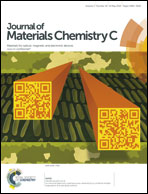Non-covalent routes to tune the optical properties of molecular materials
Abstract
Switching and tuning solid state luminescence properties of molecular materials by modulating molecular packing through non-covalent routes is an attractive prospect. This strategy further makes it feasible to expand the utility of molecules of interest by obtaining a large array of solids—polymorphs, solvates, amorphous phase, nano/micro-crystals and as multi-component systems—with distinct fluorophore arrangement and hence emission characteristics. Because non-covalent interactions that determine the fluorophore arrangements in polymorphs or supramolecular complexes are weak and flexible, their making and breaking become more realistic under ambient conditions, thus having potential to achieve reversible transformations and hence external-stimuli-responsive and switchable molecular fluorescent materials. Recent advances in this context are highlighted in this review with the aid of illustrative examples and further emphasize the scope and relevance of interdisciplinary and multitechnique approaches to unravel the structure–optical property relationships and also to augment the foundations of factual knowledge.


 Please wait while we load your content...
Please wait while we load your content...